And by icons I don't in fact mean the little things a computer user clicks on; I mean images that, however inaccurate, are recognizably referring to a religion, or something with religious content. Gatchaman isn't a very religious show, either in the sense of borrowing the outer trappings, like Haunted Junction or Neon Genesis Evangelion, or touching on the essence, as in Wings of Honneamise where an initially lazy recruit is affected by the entirely invented religion he comes in contact with. Although Jinpei utters the occasional kami-sama with folded hands in an emergency, whatever the Science Ninjas turn to when life overwhelms them, it's not any form of god. Instead, the beliefs of this world helped inspire Galactor plots and mechas, at least, in the first series when Galactor was still in touch with pop culture; in the second series, the organization changed from bizarre to truly bizarre, and in the third series, well, I'm still repressing.

Presumably because it is "Western" and the show went for a Western look, Christianity came off better than most, although the audience has not been spared a rampaging Jesus. The touch of Tibetan Buddhism may be explained by Galactor's HQ being in Cross Karakoram (an existing location in the Himalayas) although that's strictly form (creepy statues) and no content; maybe the statues were intended to make locals believe the base was a holy site, so that they would avoid it. There are no references at all to Japan's established religions, Zen Buddhism and Shintoism, or they're so subtle that I missed them completely. (According to the episode summary on Veronika's Gatchaman page(2), Katze was disguised as a Shinto priest in episode 73; however, a quick websearch on traditional Shinto priest costumes shows nothing that looks like his outfit. Shintoist priests do wear caps with a little tail on top, but it flips forward, not sideways; it looks more like Gel Sadra's headgear!)
The rather unsubtle references that I did get can be classed into five types plus a once common practice in many religions, although the show's rendering of it strikes me as fake Aztec; below are the vidcaps that go with each of them, plus an explanation of the reality behind the reference.
Ancient Egypt had a polytheist culture - although monotheism was briefly instituted by Akhnaton, only to be forcefully rejected after his death - and so "religion" was a matter of common beliefs and practices, rather than something hingeing on one deity. Most notably, the Egyptians believed that the Pharaoh was a divine emissary (the word means "house", as in, the body of the leader of Egypt housed the gods) and that for the soul to survive after death, it was necessary to keep the dead body intact. Opinions of "intact" differ; I wouldn't consider intact a body whose brains have been removed through the nose, neither do I envy the people whose job it was to remove the entrails, pickle them separately and reinsert them in a nicely wrapped package before the whole corpse was bandaged in linen and put in its final resting place. But it was worth the trouble to the ancient Egyptians, who painted murals of the deceased's soul, in the form of a bird, alighting on the body that sustained it. The body that was the house of the gods deserved special attention: it was not only embalmed, but provided with the characteristic triangle-based tomb to whose shape and proportions mysterious powers are still ascribed, and which must have cost a heck of a lot to construct. Filled with precious artifacts, these tombs, the pyramids, held a strong attraction for grave robbers, myths of mummy curses notwithstanding; though what killed the odd archaeologist was probably not the mummy's vengeful spirit, but the sometimes very nasty bacteria surviving inside the not-so-sterile corpse, ready to pounce as soon as the bandages were removed.
It's been a long time since the beliefs of the ancient Egyptians were practiced on a large scale, so what remains is the popular image of the vengeful mummy. In episode 3, a mummy plucks planes from the sky in one of Galactor's overblown schemes ("We need the invention of someone who may be on a plane, let's smash all the aeroplanes we can find") while in episode 69, the team get their own back by donning mummy disguises and scaring the living daylights out of a bunch of Galactors.
Near an airport, a mummy appears, assuming the usual "I'm a monster about to grab you" pose. (See the middle pic to get an idea of its size.)
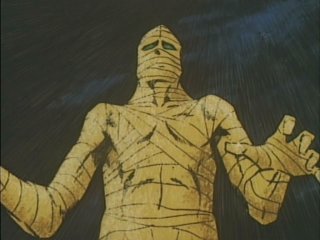

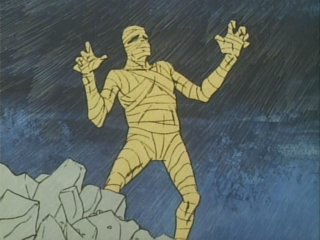
Traditionally, the mummy's big moment is when its bandages come off, revealing whatever is underneath (if anything). In this case, as befits the association of mummies with zombies and the undead, it's a hellish demon, and one who clearly enjoys his job. (Note - since this mummy's bandages were incinerated by missiles, either it has some flame-retardant bandaging or the defence forces were too squeamish to fire at its crotch.)

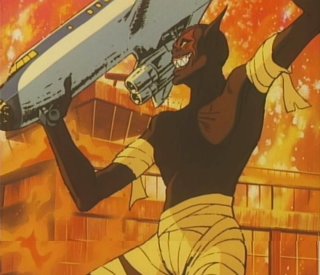
Death strikes again, this time for keeps, as the mummy mecha is destroyed by precisely the chemical substance Galactor wanted to get hold of in the first place.
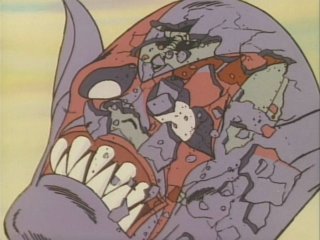

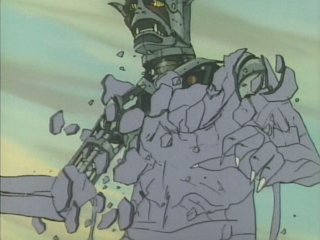

Episode 69: high stairs leading up to a pyramid, and a gaggle of Galactors charging past the hieroglyphs to catch the little kid that snuck in.
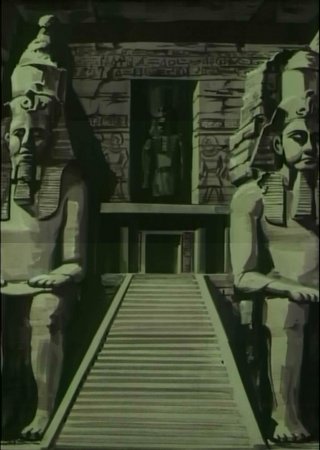
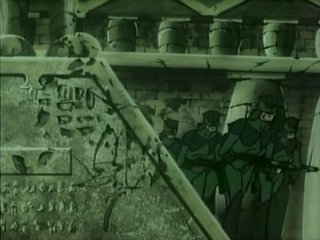
And not just a little kid. Spookily, the lights come on, the lids on the tombs (not real sarcophagi, I think, as those don't have square corners) slide away and out jump five (hint, hint) mummies who spectacularly reveal themselves. (Where did they get all that bandage at such short notice?)
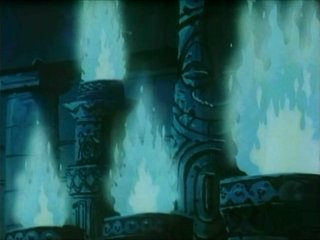
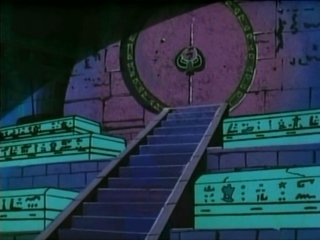
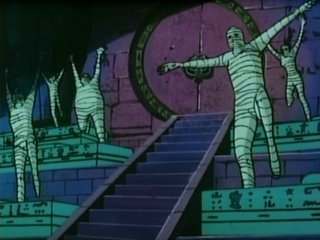

| Back to list |
"Buddha" was no more the real name of the historical figure than "Mahatma" was the real name of Gandhi; it means "awakened" and was the title awarded to the inventor of enlightenment. As far as I know, his real name was Siddharta Gautama (his wife's name was Yashodhara, for anyone interested), and he was a prince in ancient India who led a cosseted and carefree life, until the day he saw his first corpse. Inquiring what it was, and so getting his first taste of mortality, he set off on a personal spiritual quest to discover the meaning of this phenomenon called "life" before it slipped through his fingers, and in the course of much praying and meditation and trying this & that, one day achieved enlightenment while sitting under a bodhi tree.
So far, the probable historical background. Slipping into myth, Buddha might have kept his discovery to himself, but Brahma, principal god of the Indian pantheon, argued that there were people who needed just a slight push to achieve the same, and persuaded him to go public. And so, today, Buddhism is common in the far East, having made its way into China, Japan, Singapore, Birma, and most notably Tibet, where it became an amalgam of god-worship and religious practices that probably have little to do with the original.
The notion itself of achieving divine ecstasy was hardly new in Buddha's time; the word "yoga" means "union" and the many forms of yoga practiced were all intended to bring about the divine union between the human spirit and the gods. What set the enlightenment of Buddhism apart was that it was essentially free of god-worship, the idea being to make one's mind totally empty and free of clutter, where remembering a deity's name, qualities and invocations qualified as clutter. How ironic, therefore, that notably under Mongolian influence, Buddhism acquired the Dharampalas, fierce gods who aggressively defended "dharma" or spiritual purity. It is probably they who inspired both the huge statues around Cross Karakoram and the quaint defence system in the cave near the Mecha-Buddha (which should have been called Mecha-Brahma, more on that below).
Since Galactor bases always blend in, this base has at its entrance a high statue of a Buddhist monk, and another statue which I would associate with Buddhism, and not with Galactor camera surveillance...
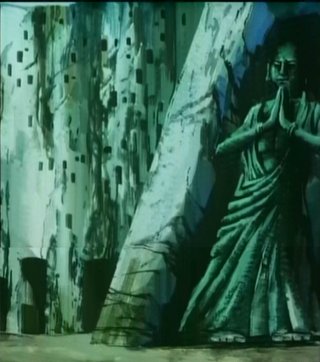
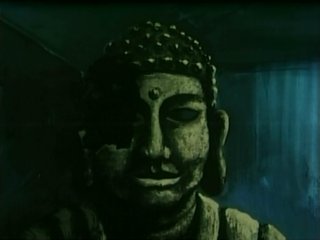
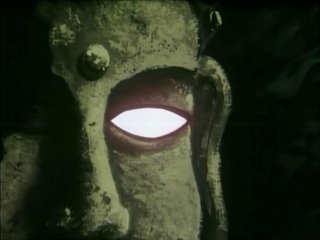
The inside of this cave would make a tourist drool.
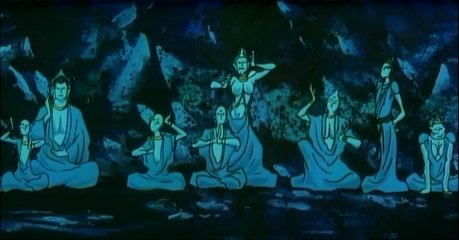
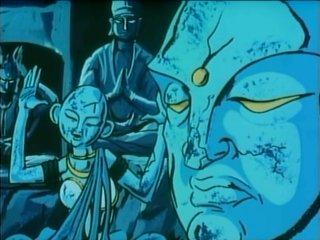
But as previous captures have shown, if it glows, it's Galactor...
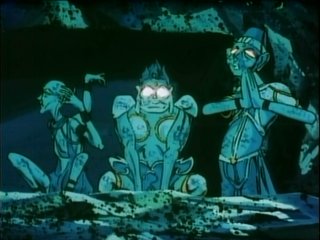
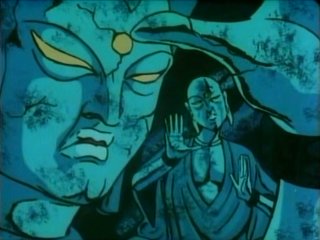
Sure enough, the (stone?) statues open their maws.
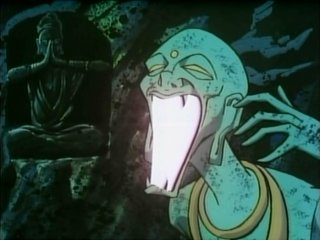
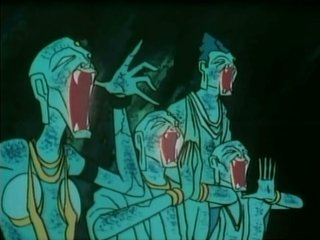
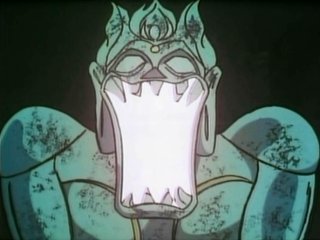
The next step is to shoot their heads at the intruders, chomping shut their jaws (which are evidently harder than stone, note Joe's look of surprise and horror).
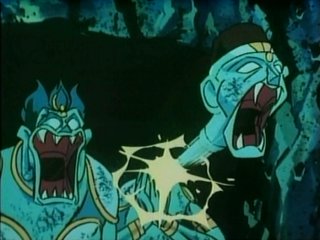



Beheaded, they act as lava spouts.
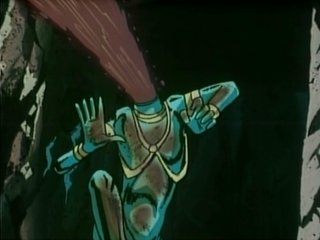
More fanged statues at Cross Karakoram. (I'm reminded of the false alarms in the film Labyrinth: "Oh please, I haven't said it for such a long time." - "Okay. But don't expect a big reaction." - "Oh nono, of course not. -ahem- Beware, for the road you are on leads to certain destruction!")
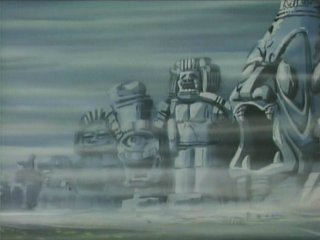
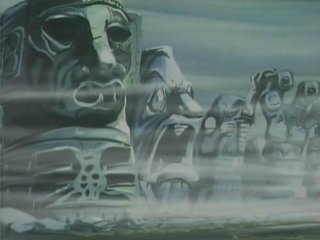

| Back to list |
It all started with a tribe living in the wetlands of Mesopotamia, the present-day Iraq. (Some still live there, they're known as "marsh Arabs".) Due to religious differences with their neighbours, the Sumerians, they left for a "promised land", picking up snippets of lore from the countries they passed through and finally settling in the Middle East where, in due time, they fell under Roman control. In that age of priests and prophets, there was a young troublemaker who thought he knew better than the religious Establishment, and was getting a fair following. The priesthood requested the Roman authorities to put him to death, and with some reluctance their wish was granted. This had an adverse effect; the new belief spread like wildfire and before long, the Romans found themselves having to take action against these Christians who refused to honour any god but their own, not even a late Roman emperor elevated to divinity.
It is probably through the Roman empire that Christianity spread into the far reaches of Western Europe, from where, in the era of colonization, it went on to conquer the Americas, thereby firmly planting the false idea that Christianity is something Western. It was certainly accepted more readily in Europe than in China and Japan, where missionaries had the inconsistencies of their beliefs pointed out to them, and generally got laughed in their faces. But the Japanese are nothing if not adaptable, and Judeo-Christian icons have found their way into manga, anime and games - sometimes in an unintentionally hilarious way.
Generally, the makers of Gatchaman demonstrate a clear lack of knowledge on the finer points of the faith (or maybe it's revenge for all those "ninja" films?) while showing they've got the rough idea: meekness, pacifism (take the Crusades, for instance -cough-) and self-sacrifice. When these three qualities have to be represented, with typical Gatch unsubtlety a crucifix is trotted out. A Gatch fan stated her belief that Joe is a "Christ figure", which another fan, a practicing Christian, argued against on the grounds that no religious imagery was used to suggest that. Then again, no religious imagery of any significance is used in this show. The first fan based herself on Joe's falling onto the cross (see the Easter eggs in the Archive, all the way at the bottom). I'd base myself on the fact that he has to die for the world's salvation, twice. Already enamoured of the kamikaze principle, the Japanese have learned from Christianity that there's no publicity like martyrdom.
But, to start with the rampaging Jesus:
Where do Galactors get their mecha ideas... An artist is commissioned to hack the likeness of Christ into a mountainside. Galactor hastily appropriates this face for a new mecha. Because the only place to hide a mecha this big is inside this mountain, or the head makes a good lookout post? Or something? Galactor logic makes my brain hurt.
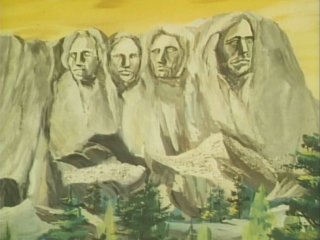
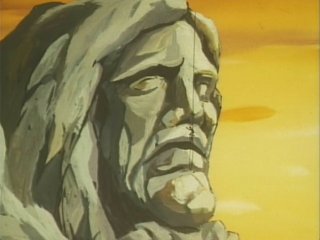
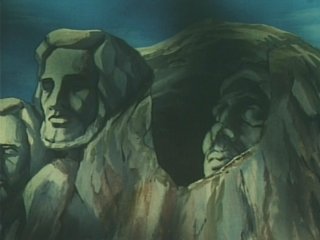
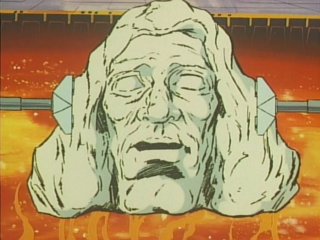
The head is popped onto a body coated with... lava. Considering the Judeo-Christian idea of hell sounds pretty volcanic, is this sadistically deliberate or just coincidence?
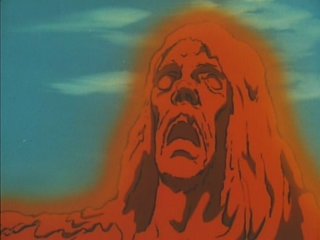

Okay, I can't resist: "Repent ye, sinners, for the end is nigh!" The end is certainly nigh for the research centre lava-Christ is rampaging towards, although in this picture it's more like tiptoeing.
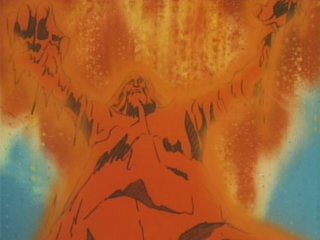

After a close confrontation with the Christ-of-fire-and-brimstone, the team and their craft cool down a bit.



This scene should dishearten a Sunday school teacher. Joe spots quite a hefty Christ effigy (what's that doing there, anyway?) and goes something like "hey, this guy looks familiar!"

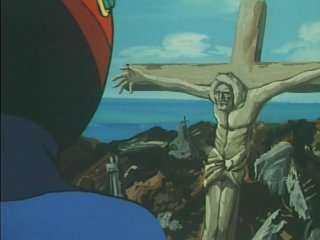
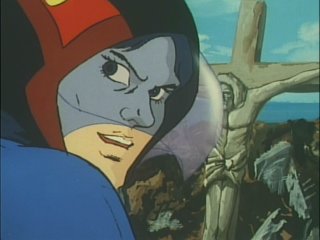
And this while Joe is the one with the churchy friend. Here's a more positive image: Alan, a Catholic priest who gives to the poor (who will be killed by Joe a bit further on for being Galactor spies).


Alan again, praying at the cross (which has no altar under it) just before Joe tumbles in, a little damaged after a fight with all the green goons on the island.



Self-sacrifice in episode 97: knowing their craft would be used by Galactor to blow up a power plant if it wasn't destroyed, two astronauts shake hands, grasp their crucifixes (symbol of sacrifice, possibly a reward in the hereafter?) and prepare to die. The explosion is followed by organ music, the final two ka-chinks being the two crucifixes falling on the ground virtually undamaged, although the craft itself is blown to bits.
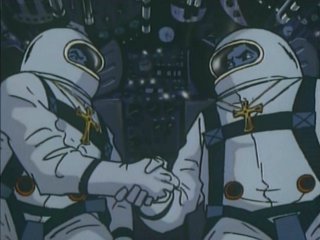
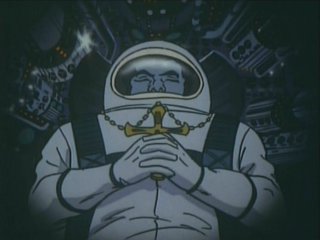

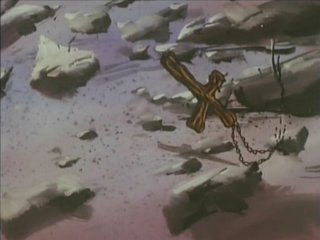
| Back to list |
In ep 58, the team are up against a four-faced marching monster called "Mecha-Buddha". Such inaccuracy. Buddha did not have four faces, but Brahma (reputedly on speaking terms with Buddha, see above) did. He was the main god of the leading trinity of the Hindu pantheon, consisting of Brahma the Creator, Shiva (who had four arms) the Destroyer, and Vishnu the Preserver who reincarnated on earth in ten forms, the Avatars. Together they stood for Brahman, the omnipresent cosmic force.
Hindu gods often have a variable number of arms, long hair piled up or tied in a top-knot, different skin colours (Krishna was reputedly blue) and a spot between the eyebrows at the supposed location of the mystical third eye, which, if open, could see the true nature of things; the physical world being only "maya", illusion.
Another mech prepared in the mountains. Once ready for action, it simply blasts its way out.
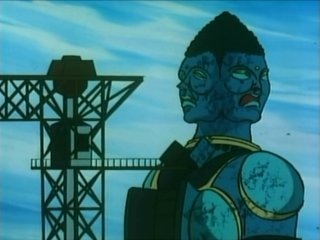


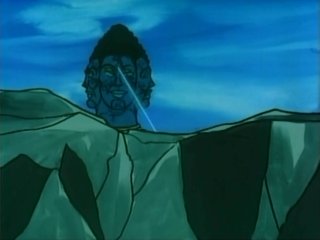
It goes down on one knee after a Bird Missile blast to the ankle, but gives back as good as it gets, revolving its head to blast rays from one face after another to give each of the four guns - one per forehead - the chance to cool down between rounds of firing.
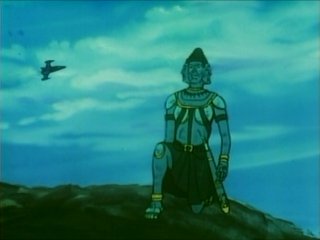
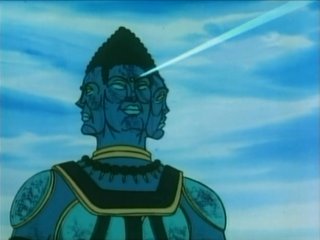
| Back to list |
The kachina belongs with the Hopis, whose name translates to "peaceful people", although their older name is "Anasazi" meaning "ancient enemy", given to them by their old neighbours, the Navajos, in remembrance of less peaceful times. It is either one of a number of spirits - Corn Maiden, Spider Woman and there may be a Buffalo in there somewhere, although the Hopis were not a buffalo-hunting tribe - or a dancer dressed like one of these in a religious ceremony, or a doll made to represent one of these. Kachinas (I think the proper plural is "kachinam") live in the hills and come down to visit mankind every year to help the crops grow; they are beneficent spirits, at least I can't recall a kachina bent on destruction. They have no neat catalogue of names, and their total number is unknown, probably because each village has its own local spirits.
The Hopis have an interesting set of prophecies about the end and rebirth of this world which seem to involve aliens, a fact which the writers of the X-Files seized on to protract their alien contact saga; and alien appearances are said to be sometimes heralded and accompanied by an immobile, obscuring cloud. However, Hopi prophecies don't mention a metal superbuffalo stepping out of said cloud with wings on its back.
Cripes, Arizona had an unexpected visitor. A ripped-off metal horn (snagged a rock during the rampage?) reveals the manifestation may not be so supernatural.
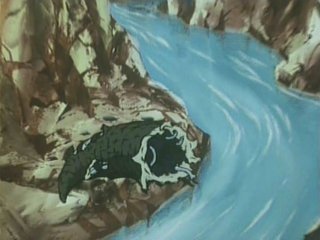
Quite convinced that it is supernatural, an old man who runs a restaurant is happy to recount an old native American legend of a tribe running into this fearful Buffalo kachina, and, well, the next picture shows a lot of skeletons.
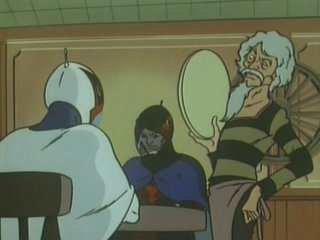
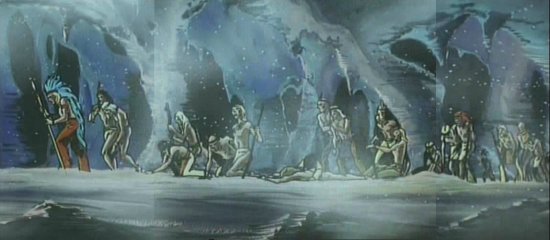
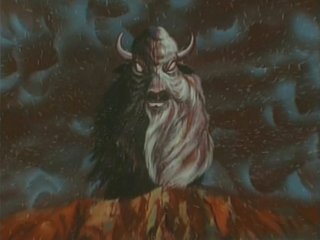
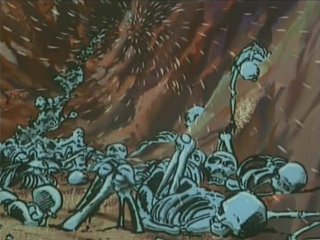
And here's the real thing. Man, it's ugly. Does it want its horn back?

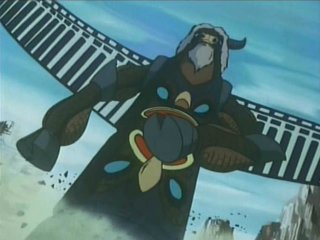
Yes, that was a swipe with the hoof. And now (snrfl) it's breathing fire.


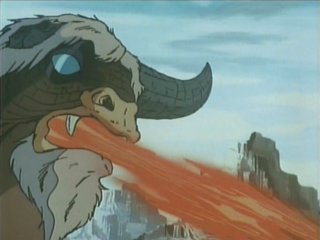
| Back to list |
One religious practice which these days is considered both ancient and barbaric - and therefore perfect for exotic locations in old Hollywood films - is human sacrifice. Laid out on a stone slab, possibly tied down to ensure cooperation, the victim lies face-up, wide-eyed, as the high priest(ess) raises the sacrificial dagger, then plunges it into the victim's chest and rips out the heart, all this preferably at the first or dying rays of the sun, with a hypnotically chanting gathering of worshippers and possibly some musical accompaniment.
In practice, as some Celtic priestesses could have told, ripping out the heart isn't so easy; it may require the prior breaking and removal of obstructing ribs, during which procedure the patient was required to laugh in a show of bravery. In ancient Crete, the sacrifices were stabbed in the neck to bleed to death. In various locations around the Mediterranean, babies were burned. The fertility gods demanded that the first of the harvest be given to them: the first ears of corn, the first lambs and kids and, possibly in the spirit of equality for all living things, the firstborn infants - all these were popped into the holy furnace. Annual sacrifice of a young male (the "king") to ensure a good crop the next year was a practice in hazy distant times which led to the Adonis myth and the traditional making of corn dollies, decoratively woven wheat stalks said to house the spirit of the Corn King through the winter; how this sacrifice was carried out, I don't know. There was a time in history when human sacrifice was simply very much en vogue, and different forms of worship entailed different methods. When it comes to doing a lot of carving, the Aztecs had the showiest rituals, beheading and gutting the sacrifice and hanging the bowels out on a rack.
Why exactly this ninja-sacrificing ceremony strikes me as fake Aztec, I don't know; it may be Jinpei's mask. Why this ceremony was held at the new mecha's inauguration at all, I can't tell - maybe they'd run out of champagne bottles.
All the ingredients for a perfect sacrifice: an altar, a mass of devotees, the high priest entering the stage with an instrument of death and the obligatory chant. Wait, something's missing. Where's the victim?
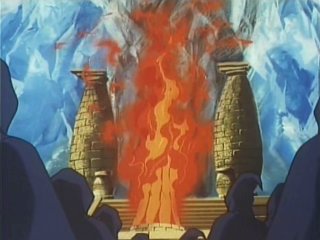
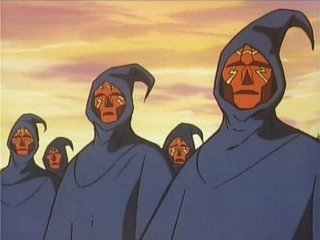
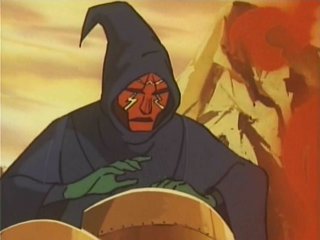
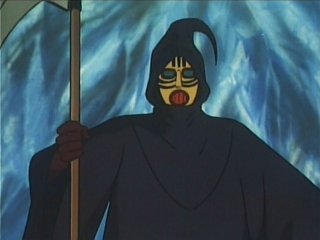
Ah.


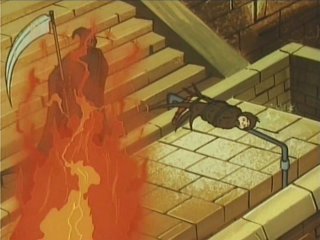
| Back to list |